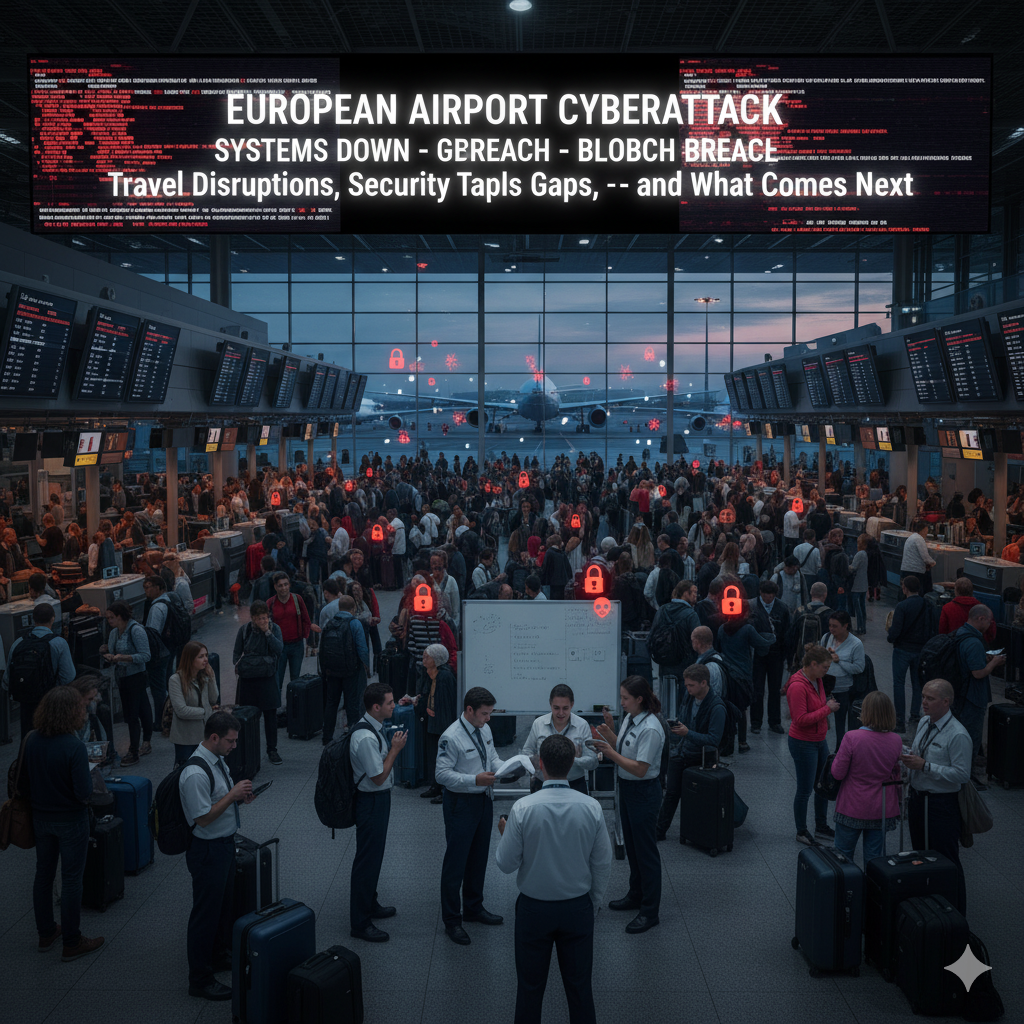Introduction: A New Frontline in Aviation Security
Yesterday, several major airports across Europe became the latest victims of a coordinated cyberattack that has caused widespread travel disruptions. The attack, which reportedly targeted airport IT systems and operational infrastructure, left passengers stranded, delayed flights, and exposed vulnerabilities in one of the world’s most critical industries.
With aviation serving as both the backbone of global connectivity and a symbol of modern economic integration, the incident underscores a pressing reality: cyber warfare has become as disruptive as traditional terrorism, with potential ripple effects across borders.
Scope of the Cyberattack: What We Know So Far
While details continue to emerge, European cybersecurity agencies have confirmed that at least seven international airports reported operational disruptions in the last 24 hours. These included failures in:
- Check-in systems that left thousands of passengers unable to board
- Baggage handling networks, causing luggage pileups and lost items
- Air traffic communication platforms, raising concerns about flight safety
Officials have not disclosed the full scale of affected passenger numbers, but early estimates suggest over 250,000 travelers faced delays, rerouting, or cancellations within the first day alone.
Who Is Behind the Attack? Early Theories
Attribution in cyberwarfare is notoriously complex, but early indicators suggest a state-backed hacker group may be involved. The tactics resemble those used in past Russian and North Korean cyber campaigns, though officials have stopped short of confirming attribution.
Some cybersecurity analysts argue this could be linked to escalating geopolitical tensions — particularly Europe’s ongoing support for Ukraine and the imposition of sanctions on Moscow. Others speculate it may be financially motivated ransomware groups seeking payouts from crippled aviation hubs.
Economic Impact: Billions at Stake
The aviation industry is uniquely sensitive to disruptions. According to IATA (International Air Transport Association), every hour of operational downtime at a major airport can cost $1–2 million in direct revenue losses. If this attack persists for several days, Europe’s aviation sector could face losses exceeding $500 million, not including secondary impacts on tourism, logistics, and trade.
Moreover, the attack comes at a time when European airlines are already under strain from rising fuel prices, labor strikes, and post-pandemic recovery challenges.
Passengers Left Stranded: Human Stories
Beyond the numbers, the cyberattack has had a deeply human cost. Social media is flooded with stories of stranded passengers sleeping in terminals, families separated due to flight reroutes, and business travelers missing critical meetings.
In Paris, thousands of passengers were left in limbo after Charles de Gaulle’s check-in systems went offline for nearly seven hours. In Frankfurt, luggage belts froze, leaving an estimated 15,000 bags unprocessed in a single day.
For many travelers, the incident has shaken confidence in air travel reliability, raising questions about whether cybersecurity is the new frontier of passenger safety.
Cybersecurity in Aviation: A Growing Vulnerability
The aviation industry has long been a high-value target for cybercriminals due to its reliance on complex digital systems. From reservation platforms to flight navigation, nearly every aspect of modern aviation is digitized.
In 2017, the WannaCry ransomware attack temporarily disrupted operations at airports in the UK and Spain. More recently, in 2022, US airports faced a coordinated denial-of-service (DDoS) attack, briefly taking down websites but not critical operations.
This latest incident, however, appears more advanced — targeting not just digital interfaces but also operational technology that directly affects aircraft movement and passenger safety.
Policy and Security Implications
European leaders are already responding with emergency meetings at the EU Agency for Cybersecurity (ENISA). The attack has reignited calls for:
- Stronger cybersecurity standards across all EU airports
- Mandatory cyber resilience audits for critical aviation infrastructure
- Enhanced intelligence-sharing between European states and transatlantic allies
The European Commission is also exploring the possibility of creating a continental cyber defense unit for aviation, modeled after NATO’s Cooperative Cyber Defence Centre of Excellence.
Global Ripple Effects
The cyberattack has not just impacted Europe. Travelers from the US, Middle East, and Asia connecting through European hubs have faced cascading delays. Logistics chains, particularly those relying on just-in-time cargo delivery, have also been disrupted.
Experts warn that similar attacks could soon target airports in North America or Asia, given the interconnected nature of global air travel. The International Civil Aviation Organization (ICAO) has called for an emergency summit to discuss strengthening global aviation cybersecurity.
What Travelers Should Do Now
For those traveling through Europe in the coming days, experts recommend:
- Check flight status frequently through airline apps rather than airport systems
- Avoid checking in baggage where possible to reduce disruption risk
- Have backup plans for ground transport or alternate routes
- Keep essential items (medicine, chargers, important documents) in carry-on bags
Looking Ahead: The Future of Aviation Security
This cyberattack serves as a wake-up call for the aviation industry. While airports have long invested in physical security against terrorism, digital security often lags behind. Analysts stress that cyberattacks are cheaper to launch, harder to defend, and can cause disruptions on par with physical attacks.
Going forward, airports may need to treat cyber defense as integral to passenger safety as body scanners and armed patrols. Investments in AI-driven threat detection, zero-trust architectures, and staff training will be crucial.
Conclusion: A Warning for the World
The European airport cyberattack is not just a European problem; it is a global warning. As air travel becomes ever more digitized, vulnerabilities expand. This incident highlights the urgent need for robust cybersecurity measures, not just to protect airports but to safeguard the millions of lives and billions of dollars that depend on them daily.
In an era where bytes can ground planes as effectively as bombs, the aviation industry — and governments worldwide — must rise to the challenge of cyber defense.







